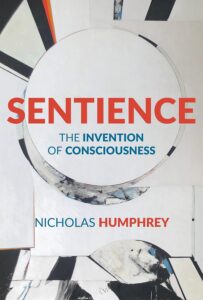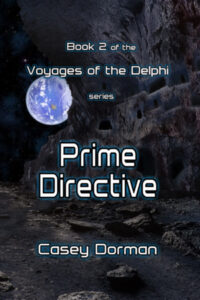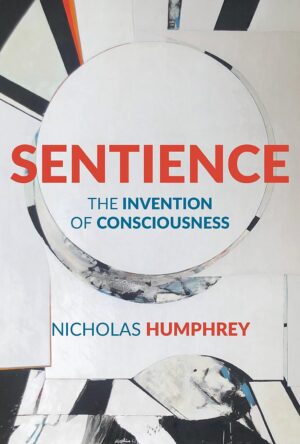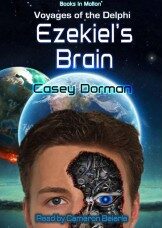Sentience by Nicholas Humphre
The MIT Press, 2023
 Nicholas Humphrey is a thinker, a distinguished scientist, a psychologist and philosopher, an anti-war activist, a literary editor, and the scion of one of Britain’s most notable intellectual families. He has worked with such luminaries as Lawrence Weiskrantz, who first identified “blindsight” in a human subject (after Humphrey had found it in a monkey), Dian Fossey, famous for studying apes in Africa, and philosopher Daniel Dennett. His writing, research and social activism have won him several awards. Needless to say, I was eager to read his latest book, whose goal is “to solve the hard problem: to explain the wondrous, eerie fact of ‘phenomenal consciousness’—the redness of a poppy, the sweetness of honey, the pain of a bee sting.”
Nicholas Humphrey is a thinker, a distinguished scientist, a psychologist and philosopher, an anti-war activist, a literary editor, and the scion of one of Britain’s most notable intellectual families. He has worked with such luminaries as Lawrence Weiskrantz, who first identified “blindsight” in a human subject (after Humphrey had found it in a monkey), Dian Fossey, famous for studying apes in Africa, and philosopher Daniel Dennett. His writing, research and social activism have won him several awards. Needless to say, I was eager to read his latest book, whose goal is “to solve the hard problem: to explain the wondrous, eerie fact of ‘phenomenal consciousness’—the redness of a poppy, the sweetness of honey, the pain of a bee sting.”
Humphrey’s writing style is highly engaging. Sentience is less a scientific treatise than a personal narrative, following his career from his early days at Cambridge, where he studied everything from mediums, who claimed to be visited from the deceased, to monkey’s brains. His story conveys his enthusiasm and openness to learning across a range of interests, all roughly psychological.
I made a lot of notes as I read Sentience. Early in the book, I noted every time that he talked about consciousness in terms of someone observing their own thoughts and sensations, e.g., when he said that “When you introspect, you observe these various [mental] states, as it were, with an inner eye.” Despite the fact that I talked in a similar vein when describing my theory of consciousness in my novel, I, Carlos, back in 2004, I had come to believe that the idea of an inner observer was a philosophical error, a sleight of hand that seemed to solve the problem of how neural representations became mental images but left you with the problem of explaining the “you” who saw them. I thought he was just being sloppy, either in his thinking or in his writing, by invoking this self-within-your-mind. As I read further, however, I found that this inner observer was a central actor in his theory.
Before going further, I have to sidetrack, as Humphrey did, to describe “blindsight,” something central both to his career and to his theory. I was familiar with the human research and some of the animal research before it, from Weiskrantz’ landmark book, Blindsight, published in 1986 (a book still well-worth reading, despite its age). The subject of the book was a man who had had one half of his striate visual cortex removed and was, so far as he and anyone else was aware, blind, in one half of his visual field. It turned out that he wasn’t, and careful experimentation revealed how much vision remained in that field, as well as his lack of awareness of it. My takeaway from that study had been that there are two neural pathways for vision, which deal with complementary, but not duplicative, information from the sensory input from the eyes, and one of them produces conscious sensation and perception and one of them does not. Information regarding presence or absence, location, and spatial orientation of a stimulus was carried by one pathway and information regarding the identity, and form of the stimulus by another. The latter pathway resulted in conscious awareness of the stimulus and the former did not. Subsequent research has extended the so-called residual visual abilities and shown similar results in subjects with both of their striate visual cortices diseased or removed. The report by subjects that they cannot “see” objects to which they can point, report their orientation and location and perhaps even, in the case of words, decipher their meaning, or discriminate between colors, was described by Weiskrantz, as “blindsight.”
In Sentience, Humphrey focuses on something that was only a background consideration for me when I read Blindsight and the related studies. Enough perception to allow an animal or person to carry out many meaningful tasks that require a response to visual stimuli can occur without any felt sense of seeing. In other words, if we regard seeing as the sensation we derive from our visual systems, we can have perception without sensation. Making the observation that many non-mammalian animals, such as frogs, do not have a striate visual cortex, and, in humans, the newborn infant’s striate cortex is not immediately functional and perhaps won’t be for several weeks, Humphrey asks the critical question of what sensation adds to perception, at the same time making the assumption that, evolutionarily, perception preceded sensation. This becomes the jumping-off point for his theory of phenomenal consciousness.
To understand Humphrey’s theory, we first have to define some concepts. Sensations involve a response to stimulation of sensory cells that produces a “qualitative dimension that sets them apart from all other mental states and attitudes.” Philosophers call this dimension “qualia,” and Humphrey agrees, although, in his informal style he calls it the “charming” quality of sensations. He seems to imply a pleasure-pain dimension, which we can acknowledge for many sensations, but I think he’s overgeneralized, since I can think of many sensations that are not, in any way I can think of, “charming.” For instance, the sensation of my fingers striking the computer keys as I type, or the image of the laptop in front of me, or the sensation of my body pressing against the seat and back of the couch I’m sitting on are qualitatively different from one another, but not along the dimension of pleasure or pain. They have no special charm. To the extent that such an evaluative component is important to his theory, I think it is not a reliable indicator of a sensation or qualia.
An important component of qualia is that sensations feel as if they are yours. It doesn’t make sense to say, “this surface feels rough, but not to me,” or “the rose looks red, but not to me,” unless you are describing someone else’s reported experience. Your sensations are yours, and they feel that way. This is a key point in Humphrey’s theory.
Consciousness is not just the awareness of sensations, it includes thoughts you have about almost anything, as long as you are aware of those thoughts. You can be conscious of calculating sums “in your head.” You can be conscious of worrying about being late to make your plane flight. Humphrey says, “consciousness means having knowledge of what’s in your mind.” By this, he means, what’s in your mind right now. I know that I know that India borders on Pakistan, but I’m only conscious of that knowledge when I’m thinking about it, usually because someone has asked. He points out that we only are conscious of a limited amount of information at any one time and appears to agree with Bernard Baars when he says that “a state is conscious when its contents are available to a global workspace in the brain.” As with sensations or phenomenal consciousness, all consciousness is personal. “Your conscious mental states comprise just those states to which at any one time you have introspective access and of which you are the subject.” This means that being conscious, whether of sensations of other thought processes, includes a sense of self. You are the one that feels sensations and knows what’s on your mind. The consciousness and feelings of which you are aware belong to you.
So far, none of what Humphrey says is different from what a lot of other theorists say about consciousness. Where he parts company from other theorists is in saying that the phenomenal quality of sensations, their qualia, which are absent in the visual realm in cases of blindsight, are necessary for an organism to be sentient. A creature “could be capable of introspection, could know its own mind, have a self-narrative, be highly intelligent, goal directed, motivated, percipient, and so on.” He says, “such a creature, by our definitions, would undoubtedly possess a form of consciousness.” But it would not be sentient. By restricting his definition of sentient to phenomenal consciousness, he has slipped something past us, which will allow him to exclude a large part of animal life as well as machines, as well as narrow the focus of his discussion.
What does he not explain? Well, the conscious experience of me reading his book or typing this review, for instance. The process of understanding words. The recognition of faces. A whole lot of what our consciousness would seem to be about., Humphrey calls this part of consciousness, “cognitive consciousness,” and distinguishes it from “phenomenal consciousness.” He admits that “we rarely find ourselves in the situation of being cognitively conscious without being phenomenally conscious,” although as he noted, at least within the field of vision, some people, who have blindsight, in fact do have one without the other, at least in a single sensory modality. By separating the two kinds of consciousness, he is able to focus on their different evolutionary trajectories. He is definite in his conjecture that cognitive consciousness preceded phenomenal consciousness, and points to both the ability of humans and monkeys to behave intelligently and adaptively without the latter (restricted to a single sensory modality, remember) and to the likelihood, based on neurophysiological evidence, that some other species who appear to get along just fine, probably lack phenomenal consciousness. This tips a lot of folk wisdom on its head. Most people would probably say simple animals, such as frogs and insects, can feel but they don’t think. He’s suggesting they have that backwards.
His evidence seems pretty flimsy to me. He only alludes to evidence regarding vision, and the definition of cognitive consciousness in the cases he cites seems pretty fuzzy. If a blindsighted individual can correctly tell you the orientation of lines that he says he can’t see, we can call that cognitive, but in what sense is that cognitive consciousness? If you ask him if he can tell you what the lines’ orientations are, he will answer that he can’t tell you, because he can’t “see them.” In fact, he will be as surprised as the experimenter that he is able to get the answer correct. In what sense does he introspectively, “know what he knows?” It seems to me that cognitive consciousness is just as elusive a concept as phenomenal consciousness, and, as in explaining how a frog is able to aim its tongue to snatch a fly from the air, it’s just as difficult to explain why the frog would need knowledge of how or what it’s doing to be conscious as it is to explain why the fly tastes “like something” after the frog catches it. For much of the book Humphrey tries to explain the selection factors that would have favored the development of phenomenal consciousness, but he fails to explain why or how cognitive consciousness was selected or developed, or why elements of cognitive consciousness, such as the sense of “me” being the one who possesses the knowledge would have been selected or what their function is.
Ignoring the development of cognitive consciousness may not be fatal for Humphrey’s theory, and he may just have been trying to narrow the focus of his discussion, but it burdens phenomenal consciousness with elevated importance in terms of characterizing the human mind and consciousness in general. Phenomenal consciousness is only part of the story, and perhaps not the most important part. A simpler scheme would seem to be to admit that both cognitive and sensory processes may function effectively without being conscious, and then raise questions about the need for and mechanisms that support bringing either of them to consciousness and allowing us to introspect on them. Occam’s razor might prompt us to think the same mechanism is involved in making either of them conscious until research shows us that we need to deal with them separately, as Humphrey does.
In terms of evolutionary selection, Humphrey asks “what does this idea—the sensation with its phenomenal properties— cause or enable or modify” in order for it to provide an advantage leading it to be selected and retained in evolutionary development? Note that we’re identifying the sensation with its phenomenal properties as an idea, which stems from his description of the process as “a representation of stimuli arriving at hour sense organs and you, the representee, read this in order to arrive at the idea of what the stimulation feels like.” So, phenomenal consciousness includes, by definition, the self-observing self. If this sounds overly complex, redundant, or homunculus-like, to you, it does to me, too, but, as I said earlier, this introspective observer is a key part of his theory. Be that as it may, he suggests that what this phenomenal consciousness we identify as a sensation enables or modifies are “action-relevant attitudes.” Particularly, when you identify the sensation as pleasurable or painful, you recognize that it is good for you or bad for you and you decide to do something about it. “You scratch the itch; you relax in the warmth of a bath.” Paradoxically, Humphrey admits that you don’t really need to be conscious of a sensation of pain or pleasure to decide what’s good or bad for you. He points out that when you pull your hand away from a hot stove, you probably do so before a sensation of pain has reached your consciousness. What’s important, he says, is “the crucial effects it has on your sense of self.” What he means is that you can assess the effects of the phenomenal experience in a general way, relating them to other experiences, to memories, to your mood, to your thoughts about your relationships, your life plans, etc. In other words, you can use the experience in developing your sense of who you are and what you’re doing with your life—either in this very moment or over the long term. Now, having phenomenal consciousness, i.e., sensations that enter your overall consciousness, is incredibly useful to such things as increasing the likelihood of your survival or of finding a partner and producing offspring. Note that having only phenomenal consciousness without cognitive consciousness might not be so valuable, but Humphrey has this covered by asserting that cognitive consciousness is already there. Both are needed for an organism to make conscious plans, which is a behavior that has considerable evolutionary advantage.
The story isn’t over yet. A major element in physically responding to a painful or pleasurable sensation, is that the response is adaptive and more so than another response. In other than reflexive responses, this means choosing how to respond. The step needed in order to do this is representing the sensation and the resultant behavioral or attitudinal responses in one’s mind where they can be accepted, rejected, modified, or saved for another day. This means, in Humphrey’s words, “privatizing” the thoughts. This can involve “motor signals that were formerly sent out to produce a response at a particular locus on the body surface [being] redirected to the place in the brain where signals from this locus come in [so] there is the potential for feedback.” He refers to such feedback to the sensory signal as a “self-entangling loop” that can sustain itself, prolonging the sensation and ideation for use in thinking. This also gives us the feeling of lingering sensations, the sweetness of sugar “staying on the tongue,” the pleasure of sex lingering as an “afterglow,” or the discomfort of pain remaining long enough to sustain associations with the situations that surrounded it and fostering avoidance behavior in the future.
This still isn’t the complete story, because there is a social advantage to having phenomenal consciousness. Being aware of one’s sensations and how they affect your decisions allows the organism that has this capacity to reason about other similar organism’s behavior. It allows the development of a Theory of Mind (ToM), or as Humphrey prefers to call it, “mindreading.” Mindreading allows prediction of others’ behaviors by anticipating how they think. It’s mostly a human capacity, although studies with apes have been inconclusive. It’s generally accepted that it is a boon to social interactions and survival in groups. Humphrey’s position is that we develop this skill by projecting what we are aware is going on in our own minds to other people and interpreting their present and future behavior on the basis of it. He further suggests that this ToM, when applied to ourselves and others, has a narrative format, which gives us a semi-fictional narrative, in Dennett’s words, “a user-illusion that is so familiar to us that we take it not just for reality, but also for the most indubitable and intimately known reality of all.” While this is a rational account of how ToM develops, recent evidence that Large Language Model AIs can pass ToM tests at the level of older children has raised questions that challenge the entire picture.
The upshot of the series of processes within an individual human or animal and in their development over eons in evolution, is the phenomenal self. The sense of “me” that is necessary to provide the unity to different sensations and to the generation of real or imagined motor responses. This sense of phenomenal self is necessary for the whole system to work and provides the sense of self that is familiar to all of us. Humphrey is clear that it is sensations—felt sensations as phenomenal consciousness—that necessitate the existence of this self. He seems to have forgotten that he said it was also a quality of cognitive consciousness, which, according to his own evolutionary timeline, developed before phenomenal consciousness was present.
When Humphrey finished with the exposition of his theory, I was more than a little dismayed by its number of questionable assumptions and conceptual gaps, but willing to write this off as one of the inevitable costs of devising such an ambitious theory. I was hoping that evidence, beyond the formidable, but mostly suggestive, evidence provided by the blindsight phenomena, would solidify at least one or two of the theory’s assertions. Alas, it was not to happen.
Humphrey’s evidence for his theory ranges from experimental tests on things such as animals’ preferences for colors or types of music or rats’ distaste for being immersed in water, which are suggestive of the sensory quality of the animals’ experiences, to lively anecdotes about his dog, Bernie, and a friend’s parrot. Coming from a neuropsychologist who has produced ground-breaking, prototypical research on the relationship of brain function and behavior, this is disappointing. It ended an intricately thought-out book by giving it a flavor of an off-the-cuff exercise in theoretical improvisation, and that is certainly not what this book is. Admittedly, his theory is a conceptual one and not a detailed, technical one. His style of writing is conducive to the idea that he is examining his own thoughts out loud with us, his readers, as his audience. He’s willing to go down some rabbit holes for the sake of seeing where they lead. Certainly, he fills the pages with provocative scientific findings and stories, mixing the two together as though they weighed equally in proving his point. To me, that’s not as convincing as sticking to the science. That said, Sentience is a genuinely fun and enlightening read, if not a convincing presentation of a tightly crafted, experimentally validated theory of consciousness. I recommend that readers interested in the mind read it for themselves to draw their own conclusions. I’m sure it will set their minds racing to pursue some of the tantalizing ideas contained within the book’s pages. It certainly did mine.
Can an AI be superintelligent, and if so, should we fear it? Read Casey Dorman’s novel, Ezekiel’s Brain on Amazon. Available in paperback and Kindle editions
Rather listen than read? Download the audio version of Ezekiel’s Brain from Audible.
Coming soon! The second novel in the Voyages of the Delphi series: Prime Directive. Release date: November 7, 2023.

Subscribe to Casey Dorman’s Newsletter. Click HERE






